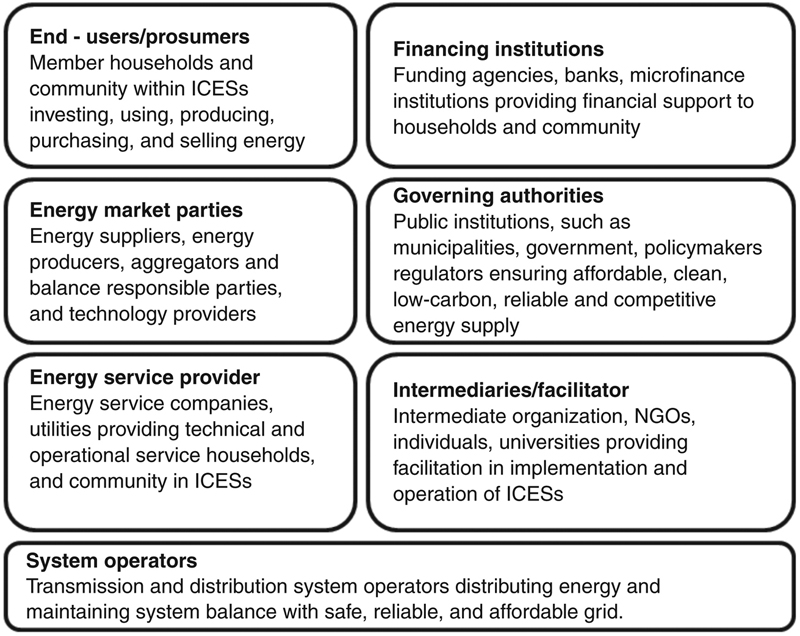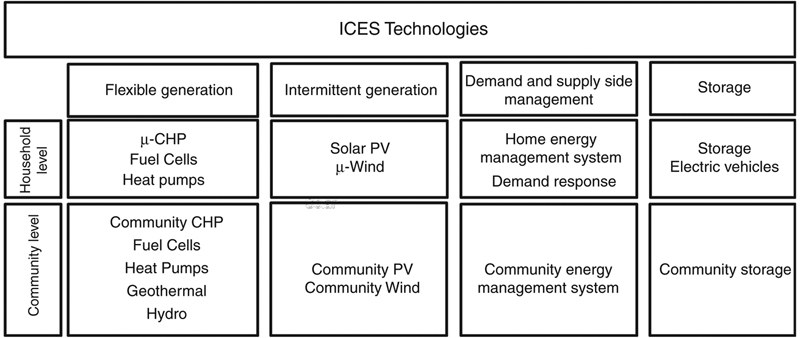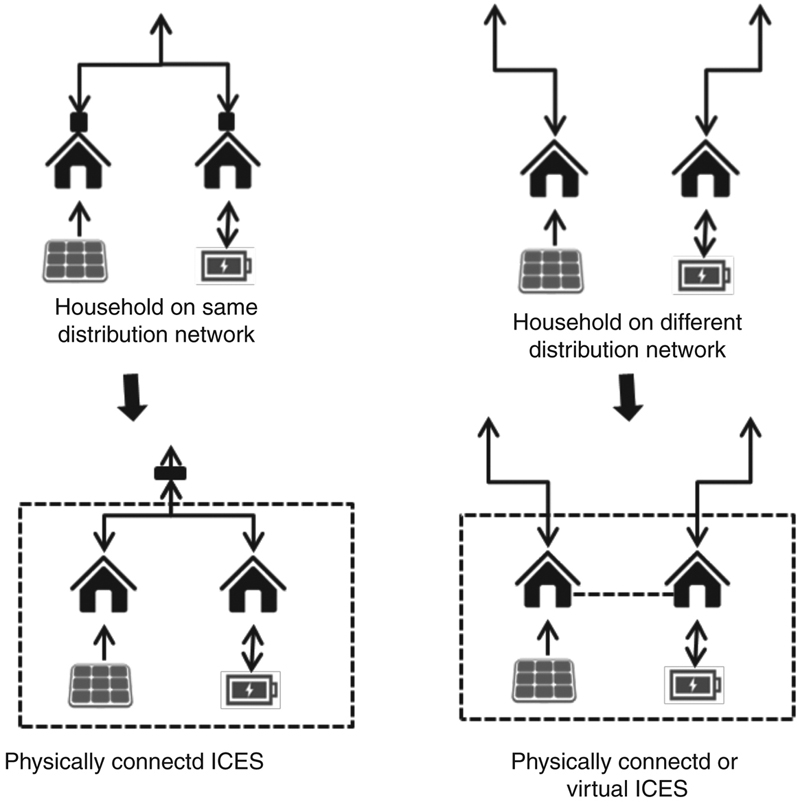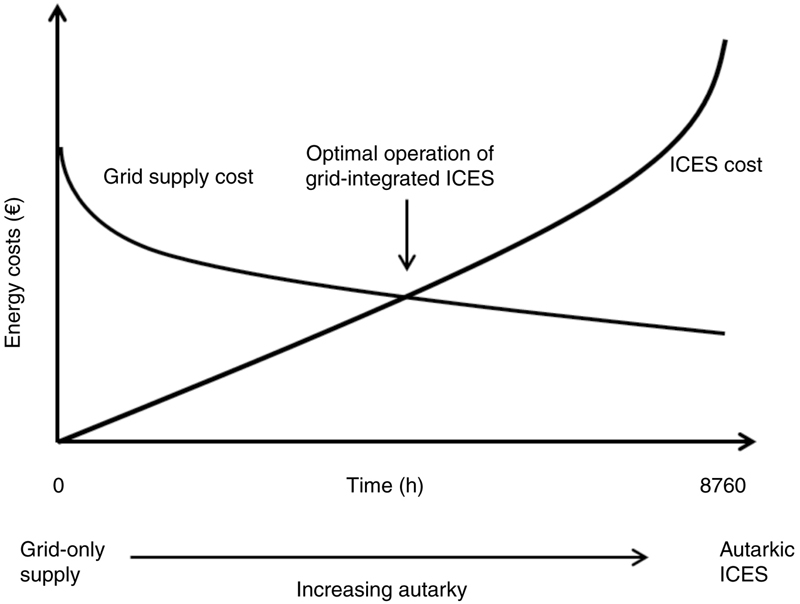Integrated Community-Based Energy Systems: Aligning Technology, Incentives, and Regulations
Abstract
Integrated Community Energy Systems (ICESs) allow simultaneous integration of distributed energy resources (DERs) and engagement of local communities. The value of such local energy initiatives is not only impacted by local consumption patterns and weather conditions but also by the institutional settings both internal and external to the system. In this context, technologies and institutions should be aligned to ensure the emergence of ICESs. The institutional design of ICESs from technoeconomic perspective is presented to achieve economic efficiency and fairness for all the actors, as well as to ensure sustainability of these local energy initiatives.
Keywords
1. Introduction

2. Rethinking local energy systems
Table 18.1
Technoeconomic Changes in the Energy Landscape
| Traditional power system | Future power system | |
| Technical | Centralized | Centralized and decentralized |
| Schedule supply to meet demand | Match both supply and demand | |
| Base load, off-peak, and peak power plants meet the demand | Decouple supply and demand with flexibility—grid expansion, demand-side management, storage and flexible back-up, low capacity factor for some technologies | |
| Passive network management | Active network management | |
| Flexibility from ramping-up and down, peak power plants, interruptible loads, interconnection | Flexibility market, demand response, storage, interconnection, curtailment | |
| Economic | Centralized day-ahead, intraday, and balancing market | Centralized markets for energy and other services and decentralized market for local flexibility |
| CO2 emissions are external | CO2 emission is internalized through carbon tax, carbon pricing | |
| Retail prices are in proportion to wholesale prices | Mismatch between wholesale and retail prices due to increasing fixed costs | |
| Volumetric network tariffs | Advanced network tariffs | |
| Price inelastic consumers | Price elastic consumers |

2.1. Integrated Community Energy Systems Concept and Definition
2.2. ICESs as Sociotechnical System

2.2.1. Actors

2.2.2. Technologies

2.3. Added Value of Integrated Approach

2.4. Benefits and Challenges of ICESs
2.4.1. Benefits of ICESs
Table 18.2
Benefits of ICESs
| Community | System operators | Policymakers |
Hedging against price fluctuations Modular in development Reliability Resiliency Economic benefits—savings and revenue generations Grid support within ICESs Higher efficiency Integrated Improved power quality Sense of community |
Improved reliability of the energy system Grid support—ancillary services and flexibility Occasional roles as service provider Investment deferrals |
Higher energy efficiency Higher renewables penetration Local economic growth Increased energy security Environmental benefits Sustainability |
2.4.2. Challenges of ICESs
Table 18.3
Challenges of ICESs
| Challenges | Description |
| Operation | Need a service provider or expert companies for complex technical operation beyond its technical capabilities |
| Financing | Access to private finance, microfinance, and loans for ICESs |
| Cost–benefit sharing | Fair allocation of costs incurred and revenue generated among actors |
| Business case | New business model for flexibility and ancillary services |
| Monetization of services | Monetization of essential community as well as other ICESs services |
| Managing utility relations or grid issues | Network access and cost recovery of network investment especially when energy networks are a natural monopoly |
3. Institutional precursors for ICESs
3.1. Regulation
3.2. Support Incentives
3.2.1. Postcode Regulation in The Netherlands
3.2.2. Community Net Metering in New York
3.3. Grid Access and Local Balancing

3.4. Aligning Institutions and Technology
4. Institutional design of ICES through technoeconomic perspective
4.1. Technical Perspective
4.1.1. Flexibility
4.1.2. Storage
Table 18.4
Different Functionalities of Storage in ICESs
| Functionalities | Community-level storage | Household-level storage |
| Balancing demand and supply | Seasonal/weekly/daily and hourly variations, peak shaving, integrated electricity and heat storage | Managing daily variations, peak shaving, integrated operation of electricity and heat storage |
| Grid management | Voltage and frequency regulation, ancillary services, participation in balancing markets | Aggregation of household storage for grid services |
| Energy efficiency | Demand-side management, better efficiency of ICESs minimize energy losses | Local production and consumption, behavior change, increase value of local generation, integrated operation |
4.1.3. Energy Services
Table 18.5
Energy Services Within ICESs and to the Larger Energy System
| Services | Description | |
| Energy-related services | Electrical energy | Electricity sold or purchased at given location and time within the ICESs and to the system |
| Flexibility | Upward and downward flexibility to the system | |
| Operating reserve | Primary: immediate, automatic, decentralized response to system imbalances stabilizing system frequency. For example, Feldheim energy community in Germany provides primary reserves for TSOs through its 10 MWh storage (NEFF, 2016) Secondary: up- or downregulation service to accommodate normal, random variations in system frequency, and normal variability and uncertainty of load and generation balance |
|
| Firm capacity | A guaranteed amount of installed capacity that is committed to producing when called upon under system-stress conditions | |
| Black-start capability | The availability of resources to restore ICESs to normal conditions after black out | |
| Network-related services | Network connection | Physical connection between the households, to the electricity distribution network and access to the associated services |
| Voltage control | Maintenance of voltage within regulated limits throughout ICESs | |
| Power quality | Minimum voltage disturbance in delivered power | |
| Congestion management | Overcoming local congestion through network reconfiguration, redispatch/utilization of generators, modifications to load or generation, utilization of flexibility from ICES members | |
| Energy loss reduction | Local consumption reduces energy losses |

4.1.4. Autarkic Design

4.2. Economic Perspective
4.2.1. Collective Financing
4.2.2. Mismatch Between Wholesale and Retail Price
4.2.3. Business Case for ICESs
4.3. Institutional Design of ICESs
4.3.1. Roles and Responsibilities
4.3.2. Design and Coordination of Local Exchange
Table 18.6
Overview of Functions and Actors in the Service and the Cooperative Model
| Functions | Service model | Cooperative model | |
| Final function | Energy use | Customers | Cooperative |
| System function | Production | Producers (decentralized) | Local production by the cooperative |
| Storage | Customers, producers, or system operators | Cooperative | |
| Transport | Operators (capacity contracted by ESCO) | Within the community, the cooperative | |
| Balance responsibility | System administrator | System administrator | |
| Coordinator | None | On community scale, the cooperative | |
| Marketing functions | Trade | ESCO | Within the cooperatives, local exchange and outside the cooperative through the national market parties |
| Delivery | ESCO | ||
| Aggregation | ESCO | ||
| Program responsibility | ESCO | ||
| Service functions | Installation | ESCO, installers | Installers in cooperation with cooperative |
| Advising | ESCO | Cooperative | |
| Market coordination | ESCO (limited) | Cooperative | |
| Financing and insurance | ESCO (in terms of the project in the community) | Cooperative | |
| Metering | Metering responsible or ESCO | Metering responsible or cooperative | |
| Communication | Through public networks or desired by ESCO | Through public networks or desired by cooperative | |
| Switching | ESCO | Cooperative | |
| Billing | ESCO | Cooperative |

ESCO, Energy service company.
4.3.3. Ownership and (Self-) Governance
Table 18.7
Ownership and Governance Model for ICESs
| Ownership | (Self-) governance |
| Community | All costs and benefits are covered by ICESs. Cooperative structure for the management and operation can be outsourced to the service provider. |
| Utility (DSO) | Utilities remain relevant in ICESs as owner, service provider or grid connection enabler, or combination of these roles. ICESs can benefit from its technical and financial capability. The utility can decide independently and level of community engagement is subjected to the utility. |
| Private | Private expert companies own and operate ICESs. Incorporating social and economic objectives of the local communities requires negotiation and bargaining. |
| Public–private (hybrid) | Joint decision-making and planning through the engagement of local communities and private expert companies. Private expert companies can hedge against future uncertainty. |
DSO, Distribution system operator.
